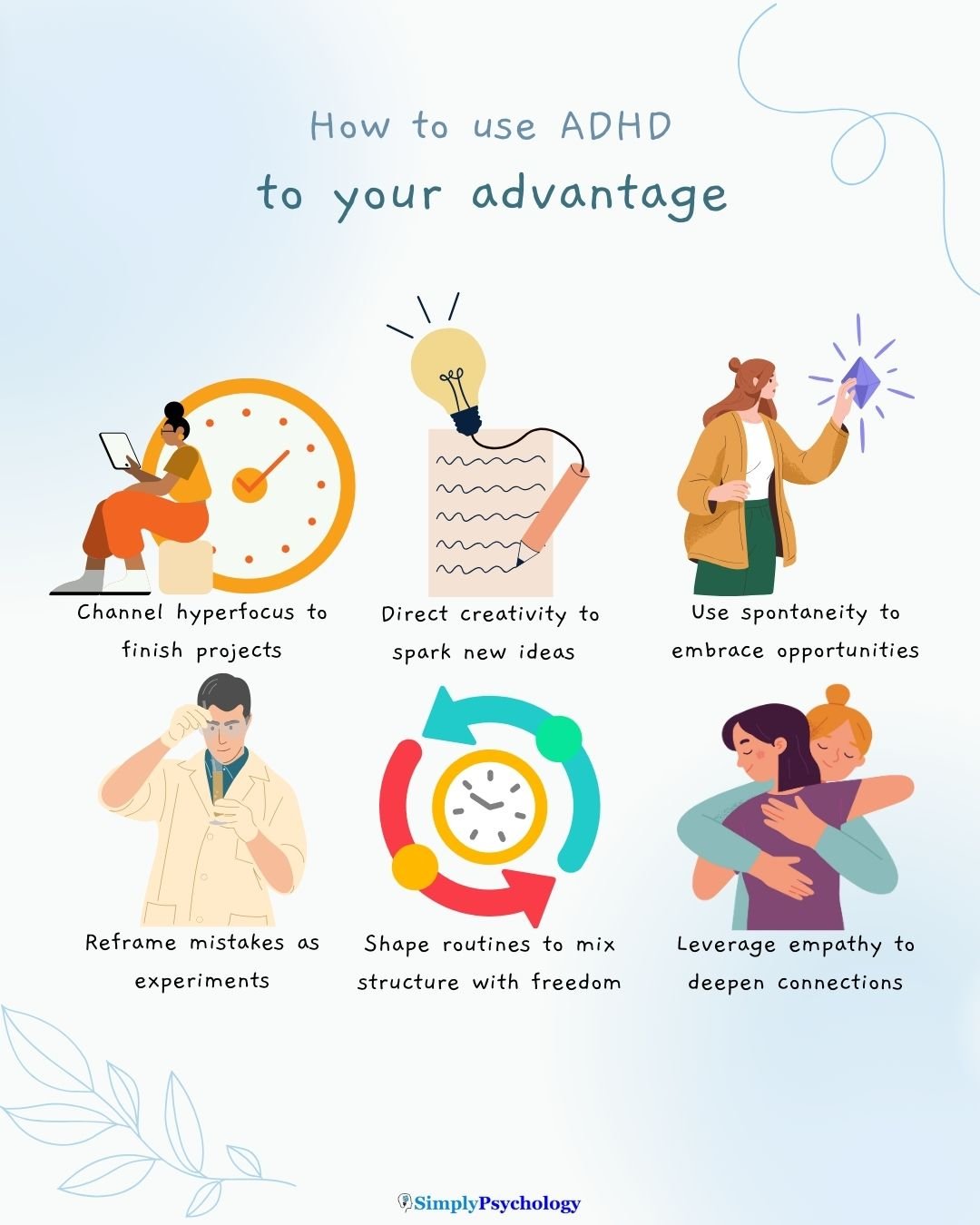Living with ADHD can be challenging, especially when it affects focus, organization, or daily routines. Yet alongside these struggles, ADHD also brings distinctive strengths that can be channeled into meaningful advantages.
Many people with ADHD describe themselves as energetic, creative, quick-thinking, and resourceful—traits that, when understood, can be powerful tools rather than obstacles.

Instead of viewing ADHD purely as a disorder, it can be reframed as a different way of thinking and engaging with the world. By learning how to direct its traits, ADHD can become a source of innovation, resilience, and connection.
Understanding the Strengths of ADHD
ADHD is often framed as a collection of deficits, but many traits commonly associated with the condition—like high energy, impulsivity, and a wandering mind—can become remarkable assets when placed in a supportive environment.
Research and lived stories reveal how these characteristics fuel creativity, resilience, and adaptability rather than drain them.
Creativity and Divergent Thinking
Individuals with ADHD frequently excel at generating novel ideas and making unexpected connections.
Dr. Edward Hallowell—a leading psychiatrist and co-author of ADHD 2.0—frames ADHD not as a disorder but a spectrum of traits that include an intense “itch to create, strive, and act”.
His strength-based approach emphasizes how these traits, when recognized and nurtured, spark innovation.
Resilience and Adaptability
Navigating the hurdles of ADHD—missed deadlines, disrupted routines, impulsive decisions—often fosters a problem-solving mindset.
Repeatedly adapting to difficult situations can build grit, flexibility, and the capacity to think on one’s feet.
Together, these strengths redefine ADHD as a toolkit for creativity and resilience—traits that, under the right conditions, can empower lifelong growth and success.
Harnessing Hyperfocus
Hyperfocus is a paradoxical strength of ADHD: while challenges include distractibility and impulsivity, hyperfocus offers the ability to sink deeply into tasks—often those that are engaging or instantly rewarding.
Defined by prolonged, intense concentration that can feel effortless, hyperfocus resembles a heightened state of flow that goes beyond typical focus patterns. It’s powerful—but like any tool, it needs direction to serve you well.
When Hyperfocus Helps Most
Hyperfocus shines in work that benefits from deep concentration—creative writing, coding, design sprints, or entrepreneurial tasks that require rapid problem-solving and idea generation.
Dr. Johan Wiklund, in a coaching blog focused on ADHD and entrepreneurship, describes how hyperfocus and strong work capacity can fuel entrepreneurs to capitalize on opportunities with immediacy and drive.
Practical Tips to Trigger Hyperfocus
- Remove distractions & create focus-friendly environments
Clear your workspace—silence or sideline your phone, block distracting sites—and use settings that resonate with you, whether it’s ambient coffee shop noise or a quiet corner. This sets the stage for deep attention. - Use clear goals, visible progress & feedback
Tasks that offer immediate feedback—like visible progress bars or fulfilling micro-tasks—engage the ADHD brain’s reward system, increasing focus. - Incorporate structured time methods
Techniques like the Pomodoro method—25 minutes of work followed by a short break—help maintain momentum while signaling your brain to stay engaged. - Move first, focus second
Physical activity (e.g., walking, HIIT, dance) just before a task releases dopamine, which primes your brain for focus. - Gamify mundane tasks
Turn routine chores or work into mini‑games—complete with points or rewards—to tap into motivation and spark hyperfocus.
Channeling Energy and Spontaneity
ADHD is often associated with high energy and spontaneity—traits that, when channeled effectively, can become valuable sources of enthusiasm, creativity, and productivity.
Instead of viewing restlessness as purely disruptive, it can be reframed as fuel that drives action.
Turning Restlessness into Action
Exercise and movement are among the most effective ways to transform restless energy into focus.
Physical activity elevates neurotransmitters like dopamine and norepinephrine—both linked to attention and executive function—which helps regulate mood and reduce hyperactivity.
Research shows that even a single session of aerobic exercise can improve concentration and cognitive control in people with ADHD.
Tips for Channeling Energy and Spontaneity
- Micro-movement breaks: Replace fidgeting with 5–10 minutes of stretching, walking, or yoga.
- Active transitions: After exercise, focus tends to be sharper for 1–2 hours, making it an ideal time to start important tasks.
- Nature plus movement: Outdoor activity, such as walking in a park, can further reduce symptoms and enhance clarity.
When directed in this way, energy and spontaneity can be transformed into strengths that support productivity and emotional balance.
ADHD and Innovative Problem-Solving
ADHD’s hallmark traits—impulsivity and rapid pattern recognition—can drive creative breakthroughs and unconventional thinking.
Impulsivity allows for swift decision-making and bold experimentation, while a flexible, diffuse attention network supports the discovery of unique connections others might overlook.
Research suggests that this cognitive style enables divergent thinking and originality in idea generation.
Fields Where ADHD Innovation Thrives
Environments that value rapid iteration and novelty—such as startups, crisis-response roles, artistic industries, and design—are particularly well-suited to these strengths.
Neurodivergent entrepreneurs often credit their ability to take calculated risks and move quickly as central to their success.
For example, bio-based reporting entrepreneurship expert Peter Shankman emphasizes seizing spontaneous opportunities as key to breakthrough achievements.
Reframing Mistakes as Experiments
A growth mindset can transform setbacks into learning moments. One forum contributor reflects:
“Instead of viewing a failed attempt as a disaster, I call it a prototype—another step closer to what works.”
Reframing failure in this way reduces shame, promotes resilience, and encourages continued exploration—turning impulsive tendencies into tools for innovation.
Tips for Using Innovative Problem-Solving
- Embrace rapid prototyping: Treat each attempt as a learn-it-quick prototype rather than a pass/fail measure.
- Welcome unpredictability: In design tasks or brainstorming sessions, intentionally break patterns or routines to stimulate fresh ideas.
- Reflect on misfires: After a misstep, analyze what worked—even in failure—and apply those insights in next iterations.
This section highlights how ADHD strengths—when understood and guided—can serve as powerful engines of innovation and creative problem-solving.
Creating Systems That Support Your Strengths
External systems—such as technology tools, accountability strategies, and structured routines—can help individuals with ADHD turn potential challenges into practical strengths.
These supports act like scaffolding, reducing cognitive load and freeing up mental energy for creativity, focus, and problem-solving.
Tools and Routines
Gamification is one effective approach. By turning tasks into games, apps like Focus Friend, Habitica or Forest provide rewards, streaks, or visual progress markers that boost motivation.
ADHD coaches often recommend these tools because they align with how the ADHD brain seeks stimulation and novelty, making it easier to stay engaged.
Visual planners, timers, and digital reminders also help by externalizing organization instead of relying on working memory.
Body Doubling
Accountability through body doubling—working alongside another person, either in person or virtually—can make difficult tasks more manageable.
Many people use Twitch or YouTube “study with me” streams for this purpose.
As one viewer explained, “Having someone on screen quietly working keeps me from wandering off; it feels like we’re in it together.” This technique reduces procrastination by providing gentle social pressure.
Balancing Structure and Flexibility
Rigid systems may backfire, but combining routine with adaptability often works best.
Therapists emphasize the value of “scaffolding with freedom”—setting up a structure that creates stability while leaving room for spontaneity.
For example, a consistent morning routine can establish momentum, while the rest of the day allows flexibility to follow creative energy or shifting priorities.
Applying ADHD Strengths in Work and Relationships
ADHD-related strengths—such as high energy, creativity, empathy, and rapid thinking—can become powerful assets in both professional and personal spheres when properly understood and applied.
Work and Career Paths
Roles that are fast-paced, dynamic, and creative tend to align well with ADHD strengths.
Opportunities in entrepreneurship, programming, and creative industries often empower individuals with ADHD to excel by leveraging problem-solving skills, innovation, and enthusiasm.
According to ADHD coach Stephanie Potter, clients who embrace their spontaneity, emotional sensitivity, and strong problem-solving capacity often discover uniquely effective career approaches—even spotting problems that others don’t.
Relationships and Teamwork
ADHD-driven traits like enthusiasm, empathy, and a sense of humor can enrich relationships and group dynamics.
For example, a forum contributor shared that their impulsivity makes them “the friend who always says yes to adventures,” helping to establish spontaneity and connection.
Psychologist Ari Tuckman emphasizes in interviews that while ADHD doesn’t create new relationship challenges, it can intensify existing ones—making self-awareness and mutual communication key to thriving personal connections.
Tips for Applying ADHD Strengths at Work and in Relationships
- Match roles to passions: Seek work that aligns with personal interests and energy, such as creative or problem-solving fields.
- Frame impulsivity positively: See spontaneous actions as opportunities for connection and innovation.
- Communicate openly: Share how ADHD traits manifest, and establish structures or check-ins that support clarity and emotional balance in relationships.
References
Mehren, A., Reichert, M., Coghill, D., O Müller, H. H., Braun, N., & Philipsen, A. (2020). Physical exercise in attention deficit hyperactivity disorder – evidence and implications for the treatment of borderline personality disorder. Borderline Personality Disorder and Emotion Dysregulation, 7, 1. https://doi.org/10.1186/s40479-019-0115-2
Taylor, C. L., Zaghi, A. E., Kaufman, J. C., Reis, S. M., & Renzulli, J. S. (2020). Divergent thinking and academic performance of students with attention deficit hyperactivity disorder characteristics in engineering. Journal of Engineering Education, 109(2), 213-229. https://doi.org/10.1002/jee.20310

